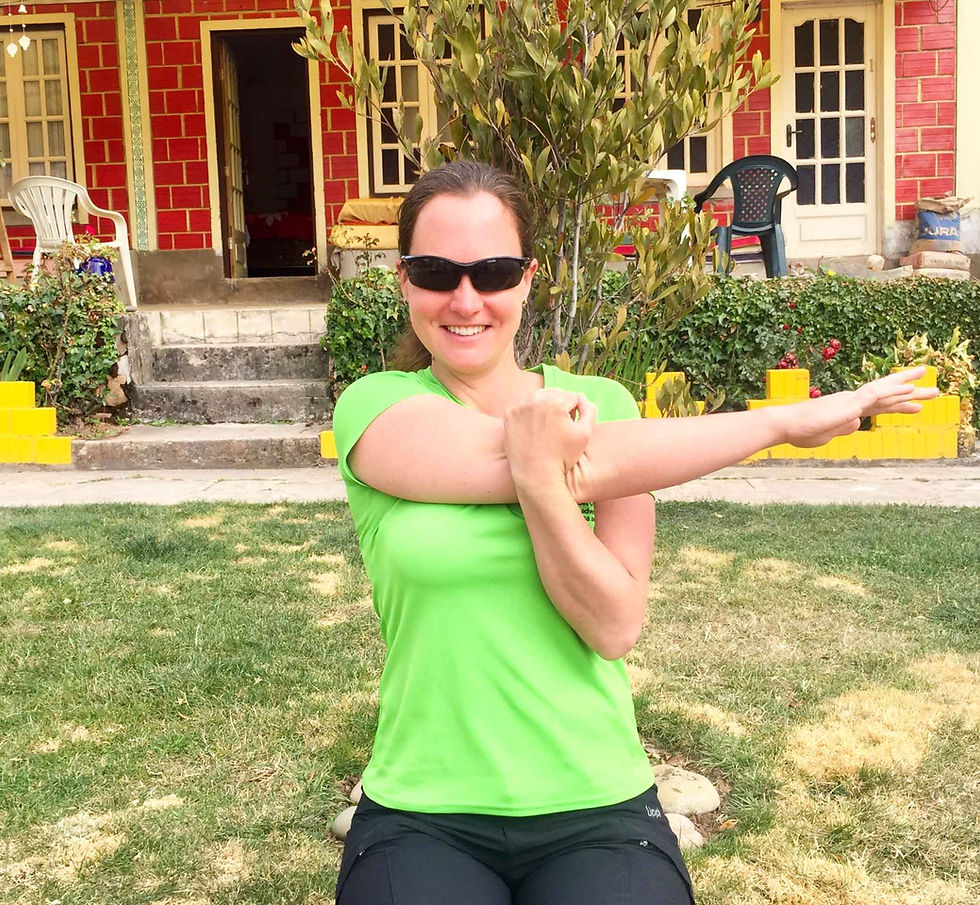Suzie Says...Rehab Shoulder Injuries - Exercise Progressions
- Suzie Prevett

- Mar 2, 2019
- 4 min read
Updated: Jun 29, 2020
Disclaimer: This article is intended to be for educational purposes only, and does not constitute medical advice or replace professional assessment. Please seek a professional assessment before undertaking a new exercise program especially if you have any medical conditions, any previous or current injuries or other health / physical concerns. If you undertake any of the exercises within this article you do so at your own risk.
Any website pages/links added are also for education purposes only and are not under my control and may change or be removed at any time.
So, once you're doing the exercises in 'The Basics' blog posted previously, you can move onto these exercises. Again, it is important that you do not get pain with the exercises.
Internal/External rotation and Abduction with theraband.
External Rotation - Hold a theraband between your hands, elbows at 90°. Place a small rolled up towel or similar between your side and elbow as shown. Keep your unaffected arm still and rotate your affected arm outwards pulling the band, keeping elbow in. Slowly return to start. Here I am demonstrating an effected right shoulder.
Repeat 8-12 reps x 3, once every two days.

Internal Rotation - Attach the end of a theraband to a door-handle/sturdy object etc. Elbow bent, stand side on to the theraband and rotate your affected arm inwards pulling the band. Slowly return to the start. Here I am demonstrating an effected right shoulder.
Repeat 8-12 reps x 3, once every two days.

Abduction - Hold a theraband between your hands, arms straight down. Keep your unaffected arm still and take your affected arm out to the side a little. Slowly return to the start. Here I am demonstrating an effected right shoulder.
Repeat 8-12 reps x 3, once every two days.

High to low rows
Securely attach the middle of a theraband up in front of you. If it’s too low you can kneel with one knee bent up (as shown in the picture). Hold the ends of the band in each hand. Pull the band down, bending your elbows and gently squeezing your shoulder blades together. Don’t lift your shoulders up. Relax to start position.
Repeat 8-12 reps x 3, once every two days.

Wall slides
Stand facing a wall. Place your forearms on the wall and slowly slide them up the wall with mild pressure keeping good posture. Return to start. Repeat 8-12 reps x 3, once a day.

Side wall slides
Stand sideways right next to a wall. Place the back of your hand on the wall. Keeping a slight pressure through the back of your hand onto the wall, lift your arm up in front of you slowly and then slowly return to the start position. Repeat all 8-12 reps x 3, once a day. Here I am demonstrating an effected left shoulder.

Prone Extrenal Rotation
Lie on your tummy with your affected side (or side you want to work on) right on the edge of a bed/plinth. Take your arm out to 90 degrees and elbow bent to 90 degrees, with the forearm relaxed down. You may need to place a rolled up towel of similar under the front of your shoulder for support so that its not dropping down. Now rotate your shoulder so your forearm moves up (upper arm stays level with your body and at 90 degrees to your torso), and then slowly lower it back down. Here I am demonstrating an effected left shoulder.

To make this harder you can hold a small weight in your hand. Here I am demonstrating an effected left shoulder.

Repeat 8-12 reps x 3, once every two days.
Pec stretch
Stand next to a wall edge or door frame. Take your arm out to the side at about 70-90 degrees and bend your elbow. Place your arm against the wall. Next, rotate your body away from your arm until you get a gentle stretch in the front of your shoulder and / or in your pec (chest) area. This should not be painful. If it is, adjust the position of your arm on the wall. Hold this for 30 seconds then gently release. Repeat 3-4 stretches, 3-4 times a day. Here I am demonstrating an effected right shoulder.

Horizontal adduction stretch
Take your arm directly across your body so that your arm is in line with the level of your shoulders (or there about). Use your other arm to help. You should feel a gentle stretch in the back of your shoulder. Hold this for 30 seconds then gently release. Repeat 3-4 stretches, 3-4 times a day. Here I am demonstrating an effected right shoulder.

NOTE: Only do what is pain free and build up slowly. For all ‘Theraband’ exercises, start with the easiest and slowly progress. For the Theraband branded exercises bands, yellow is the easiest, then red, green, blue and finally black. Personally I have never used black for any upper limb rehabilitation as it's very strong. If the bands are too easy, get to a physiotherapist for some higher level, functional exercise. In the above photos I have used a green band however this is not a branded Theraband exercise band, and is similar to the strength of a red Theraband.
For a video of all these exercises and the basic ones from the previous blog please click HERE.
If you have had a shoulder injury and you don't know what the injury is or it is causing a lot of pain (especially if it's persistent), it's always best to get an assessment because different injuries require different exercises.
If you have hurt your shoulder and you are struggling to lift it up without assisting it (especially a few days after it's settled) you MUST get an assessment to check you have not completely torn your rotator cuff (e.g. one of the tendons like the supraspinatus).
References
Luime JJ, Koes BW, Hendriksen IJ, Burdorf A, Verhagen AP, Miedema HS, Verhaar JA. Prevalence and incidence of shoulder pain in the general population; a systematic review. Scandinavian journal of rheumatology. 2004 Mar 1;33(2):73-81







Comments